How Architects Shape Public Spaces That Connect Communities?
- Updated October 18, 2025
Public spaces are essential elements of urban life, shaping the way communities interact and thrive. Parks, plazas, promenades, and open squares are more than just physical areas; they are hubs where social interactions occur, culture is celebrated, and community identity is reinforced.
Architects play a crucial role in creating these spaces, transforming ordinary locations into environments that foster connection, engagement, and well-being.
In contemporary cities, where digital interactions are prevalent, well-designed public spaces provide opportunities for meaningful face-to-face engagement. A professional architect in Surat balances aesthetics, functionality, and accessibility to create spaces that encourage people to gather, interact, and form lasting bonds.
Designing Spaces Focused on People
Architecture is not solely about constructing buildings; it is about shaping experiences. Public spaces are most effective when they are designed with people at the center. Architects consider elements such as walking paths, seating arrangements, lighting, and shading to ensure that spaces are welcoming and comfortable for all users.
Well-planned public areas facilitate casual encounters and shared experiences, promoting social cohesion.
Thoughtful design encourages residents to engage with their surroundings and with each other, creating a strong sense of community. Engaging a skilled architect in Surat ensures that urban spaces are functional, visually appealing, and socially vibrant.
Integrating Nature and Urban Life
Modern urban planning emphasizes the integration of natural elements into city spaces. Architects incorporate greenery, water features, and open landscapes to create environments that are calming and sustainable. Parks, green corridors, and eco-friendly plazas contribute to better air quality and provide spaces for recreation and social interaction.
Connecting communities with nature not only enhances physical well-being but also strengthens social bonds. Urban spaces that combine built infrastructure with natural elements invite residents to gather, relax, and interact, fostering a sense of collective ownership.
Promoting Interaction Through Design
Public spaces are most effective when they encourage social interaction. Architects design areas that support a variety of activities, including community events, outdoor performances, and casual gatherings. Features such as amphitheaters, playgrounds, seating clusters, and art installations provide opportunities for residents to engage naturally.
Flexible and multifunctional layouts ensure that spaces serve diverse populations and accommodate different types of interactions. Architects create platforms where community members can share experiences, build relationships, and form lasting connections.
Reflecting Culture and Identity
Public spaces are also a reflection of a community’s culture, history, and identity. Architects incorporate local heritage, cultural motifs, and public art to create spaces that resonate with residents. These design elements foster a sense of pride and belonging while celebrating the unique characteristics of the community.
Collaboration with local artists and historians ensures that public spaces maintain cultural authenticity and engage the community meaningfully. Working with a professional architect in Surat can help blend traditional elements with contemporary design, creating spaces that are culturally relevant and socially inclusive.
Accessibility and Inclusivity
Inclusivity is a critical aspect of public space design. Architects ensure that all members of the community, including the elderly and people with disabilities, can access and enjoy public areas. Features such as ramps, tactile paths, seating with shade, and clear signage are essential to creating welcoming environments.
Inclusive spaces also consider programming that caters to diverse interests, from workshops and recreational activities to social gatherings. By promoting equitable access, architects strengthen community cohesion and enable meaningful interactions across different demographic groups.
Leveraging Technology in Public Spaces
Technology plays an increasingly important role in modern public space design. Architects use 3D modeling, simulations, and smart infrastructure to anticipate user behavior, optimize space utilization, and enhance safety. Digital tools also allow communities to provide feedback during the design process, resulting in spaces that better meet residents’ needs.
Interactive installations, smart lighting, and digital engagement platforms make public spaces more dynamic, responsive, and engaging. Integrating technology ensures that these areas remain relevant and functional as communities evolve.
Sustainable Design for Lasting Impact
Sustainability is an integral component of public space planning. Architects incorporate environmentally responsible features such as rainwater harvesting, energy-efficient lighting, green landscaping, and sustainable materials. These measures not only minimize environmental impact but also encourage community participation in sustainable practices.
Public spaces that connect people with nature inspire collective responsibility and a sense of stewardship. Thoughtful, sustainable design enhances the quality of life while strengthening social connections within communities.
Conclusion: Building Connections Through Architecture
Public spaces are essential for creating vibrant, connected communities. Architects shape these areas with careful consideration of social, cultural, and environmental factors. By prioritizing human-centered design, integrating nature, promoting inclusivity, and incorporating technology, architects create spaces that foster interaction, strengthen social ties, and celebrate community identity.
Engaging a professional architect in Surat ensures that public spaces are thoughtfully planned and effectively executed, transforming urban areas into hubs of connection, engagement, and shared experience.
Well-designed public spaces are not just functional environments; they are the foundation for thriving communities where people come together, share experiences, and build lasting relationships. Prashant Parmar is a visionary architect known for creating innovative and functional spaces that blend aesthetics with practicality.
Our designs reflect a deep understanding of modern architecture while connecting communities through thoughtful planning.












